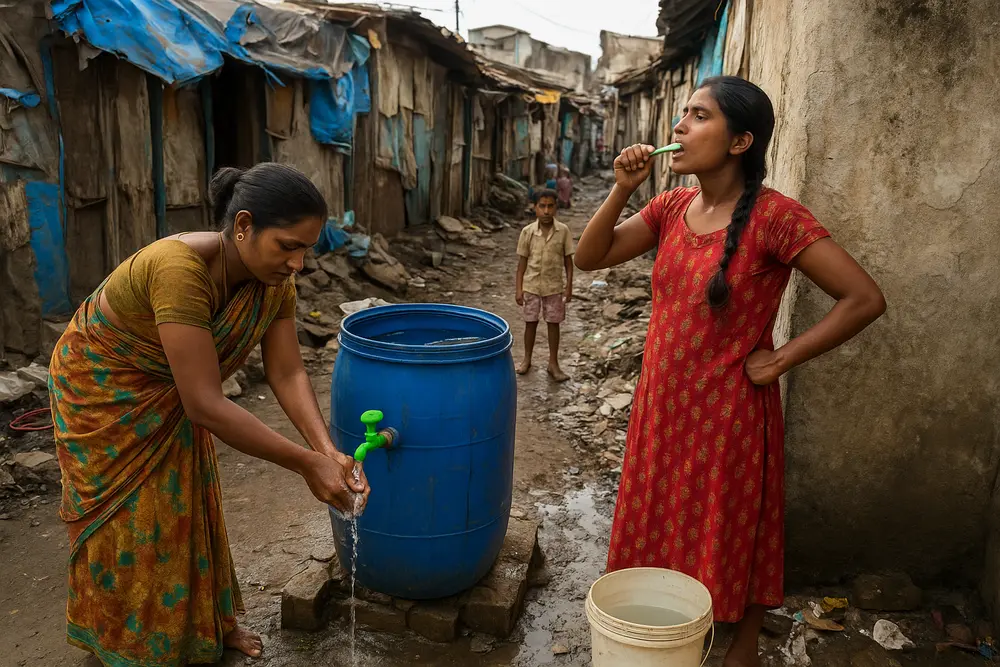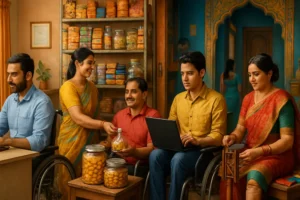Imagine living in a place where clean water is scarce, toilets are few, and waste piles up in every corner. For millions in India’s slums, this is daily life.
Poor sanitation doesn’t just cause discomfort—it spreads deadly diseases, affects children’s growth, and steals away dignity.
But here’s the good news: change is possible. With smart solutions, community participation, and the right support, slums can transform into healthier spaces.
So, how can we really improve sanitation and hygiene in Indian slums? Let’s explore!

How to Improve Sanitation and Hygiene in Indian Slums in 2025
India’s urban population has been rising at an unprecedented pace, and with it, the number of people living in informal settlements or slums.
More than 65 million Indians live in such areas, often without proper access to clean water, toilets, or waste disposal systems.
Poor sanitation not only affects daily living conditions but also fuels the spread of diseases such as cholera, typhoid, and diarrhea, which remain leading causes of child mortality in slum communities.
In 2025, India faces both a challenge and an opportunity. The challenge lies in ensuring sustainable sanitation for growing urban populations, while the opportunity lies in leveraging technology, community-driven models, and government initiatives to make real improvements.
In this article, we will explore 10 effective and practical ways to improve sanitation and hygiene in Indian slums—approaches that are realistic, affordable, and impactful.
Read Here: Importance of Personal Hygiene and Cleanliness
10 Effective and Practical Ways to Improve Sanitation and Hygiene in Indian Slums
Improving sanitation and hygiene in Indian slums is not just a public health necessity—it’s a matter of dignity, equity, and sustainable development. Here are 10 practical, effective ways to make real progress:
1. Expanding Access to Clean and Safe Water
Water is the foundation of sanitation, yet millions in Indian slums rely on contaminated sources.
In 2025, solutions must prioritize reliable and affordable access to clean water. Community water taps connected to municipal supplies, rainwater harvesting systems, and decentralized purification units can help bridge the gap.
Innovative approaches like water ATMs, which dispense clean water at nominal costs using smart cards, have already shown success in states like Delhi and Gujarat.
Additionally, integrating AI-based monitoring systems ensures that water sources remain safe and regularly tested.
Local governments and NGOs can also invest in solar-powered borewell pumps to provide consistent supply where infrastructure is weak.
By improving access to clean water, slums can reduce the burden of waterborne diseases. Importantly, these systems must be managed with community participation to ensure accountability and proper maintenance.
Reliable clean water is the first step toward achieving sustainable hygiene in urban slums.
2. Affordable and Accessible Public Toilets
One of the most pressing sanitation issues in Indian slums is the lack of safe toilets. Open defecation remains common, posing severe health risks.
In 2025, the solution lies in building affordable, accessible, and inclusive public toilets tailored for dense slum populations.
Smart innovations like bio-toilets, which use bacteria to decompose waste without needing heavy infrastructure, have already been introduced on Indian trains and can be adapted for urban slums.
Solar-powered units can provide lighting, ensuring safety for women and children at night. Gender-friendly spaces with menstrual hygiene facilities make these toilets inclusive and secure.
Pay-per-use models, supported by government subsidies and CSR initiatives, can keep facilities sustainable while discouraging misuse.
NGOs can train local youth in toilet maintenance, creating jobs while ensuring cleanliness.
By designing slum-friendly, low-cost public toilets, India can make major strides toward eliminating open defecation, improving dignity, and protecting public health in urban communities.
3. Waste Management and Recycling Initiatives
Overflowing garbage is a daily reality in many Indian slums. Poor waste management leads to clogged drains, mosquito breeding, and foul surroundings.
In 2025, effective solutions require segregation, collection, and recycling systems that empower slum residents while keeping costs manageable.
Door-to-door garbage collection, run by local cooperatives or NGOs, can provide jobs while ensuring regular waste removal.
Training residents in waste segregation at source—separating wet and dry waste—makes recycling easier.
Some Indian cities already use waste-to-energy plants where organic waste is converted into biogas or electricity, and such models can be extended to slums.
Recyclables like plastic, metal, and paper can generate income for waste pickers, creating a circular economy.
Awareness campaigns, combined with low-cost bins, encourage household-level participation.
Importantly, partnerships with municipal corporations are essential to ensure timely transport and processing of waste.
Cleaner environments not only reduce disease but also enhance dignity and living conditions in slums.
4. Drainage and Flood-Resistant Infrastructure
Slums often lack proper drainage, leading to frequent waterlogging and floods during monsoons.
Stagnant water becomes a breeding ground for mosquitoes, spreading malaria and dengue. In 2025, tackling this requires low-cost, modular, and flood-resistant drainage systems adapted for slum conditions.
One approach is installing pre-fabricated modular drains that can be quickly assembled without large-scale excavation.
Community-led cleaning drives, supported by municipal workers, can ensure drains remain unclogged.
Green infrastructure, such as permeable pavements and vegetation-based filters, helps absorb rainwater while reducing runoff.
Government programs like the Atal Mission for Rejuvenation and Urban Transformation (AMRUT) are funding urban drainage improvements, and these must be expanded to include informal settlements.
Additionally, NGOs can provide training on household-level flood preparedness, such as raised platforms for toilets and water storage.
By combining innovative engineering with community participation, slums can become more resilient against floods, improving health and reducing long-term costs.
5. Community-Led Hygiene Education Programs
Even with infrastructure improvements, lasting change depends on behavioral shifts. Many sanitation problems in slums stem from lack of awareness about hygiene practices.
In 2025, effective hygiene education must be community-driven, culturally relevant, and engaging.
Local NGOs can train peer educators—respected slum residents who spread knowledge about handwashing, waste segregation, and safe water practices. Schools play a vital role: children can learn hygiene habits and influence their families.
Creative approaches, such as street plays, wall paintings, and digital awareness campaigns, make learning accessible and fun.
Mobile apps and WhatsApp groups can also spread quick hygiene tips, especially in urban slums where smartphone use is rising.
Importantly, education campaigns must address myths and taboos around sanitation, particularly concerning women’s hygiene.
When communities themselves drive education, adoption rates improve significantly. A slum where residents understand and practice hygiene collectively is one step closer to sustainable sanitation.
6. Promoting Women-Centric Sanitation Facilities
Women and girls face unique sanitation challenges in slums. The lack of safe toilets often forces them to wait until night, risking their health and safety. In 2025, gender-sensitive sanitation facilities must be prioritized.
Dedicated women’s toilets equipped with menstrual hygiene management systems—such as sanitary pad vending machines and disposal units—are essential. Clean, well-lit spaces with locks enhance safety and dignity.
Community-based women’s groups can oversee maintenance, ensuring facilities remain functional and trusted.
NGOs like WaterAid have shown that when women are directly involved in designing and managing sanitation projects, facilities are better maintained and widely used.
Local governments and private companies can provide funding through CSR initiatives, ensuring sustainability.
Improving sanitation for women goes beyond health—it improves school attendance, enables economic participation, and protects dignity. By addressing women’s needs, sanitation programs can create more inclusive and healthier slum environments.
7. Leveraging Technology for Hygiene Solutions
Technology is transforming how sanitation is managed. In 2025, innovative tools can make hygiene in slums more effective, transparent, and sustainable.
IoT-enabled sensors can monitor the usage and cleanliness of public toilets, alerting authorities when maintenance is required.
Mobile apps can allow residents to report sanitation issues, like overflowing drains or broken toilets, directly to municipal corporations.
Digital platforms can also provide hygiene education, with short videos and reminders on handwashing and waste management.
Startups are experimenting with eco-friendly sanitation solutions, such as self-cleaning toilets and low-cost water filters.
Some cities are testing AI-based systems to map waste hotspots, allowing better planning of garbage collection routes.
Importantly, technology must remain affordable and accessible to slum communities.
By combining digital innovation with community training, slums can overcome long-standing sanitation barriers and achieve cleaner, healthier environments.
8. Strengthening Public–Private Partnerships (PPPs)
Improving sanitation in slums cannot rely on the government alone. Public–Private Partnerships (PPPs) can bring in much-needed innovation, funding, and efficiency.
Private companies can contribute through Corporate Social Responsibility (CSR) funds, supporting the construction of toilets, waste treatment plants, or water purification systems.
NGOs, with their grassroots experience, can bridge the gap between residents and authorities.
Startups bring fresh ideas, such as bio-digesters or portable toilets, which can be scaled with government support.
Successful PPP models already exist. For example, some Indian cities have partnered with private firms to run pay-and-use toilet complexes, ensuring sustainability.
Similarly, companies have funded school sanitation programs, improving hygiene for children in slum communities.
In 2025, strengthening these partnerships means aligning goals—government provides regulation and oversight, private companies offer resources and innovation, and communities ensure participation. This three-way collaboration can make sanitation programs more efficient, accountable, and impactful.
9. Government Schemes and Policy Implementation (2025 Updates)
India’s government has launched several schemes to tackle urban sanitation, but effective implementation in slums remains the key challenge.
In 2025, initiatives like Swachh Bharat Mission 2.0 and AMRUT 2.0 focus on sustainable waste management, water supply, and urban resilience.
Swachh Bharat 2.0 emphasizes slum sanitation with bio-toilets, faecal sludge management, and awareness campaigns.
Meanwhile, AMRUT 2.0 works to provide tap water connections to every household, including slum dwellers.
Housing schemes such as PM Awas Yojana also integrate sanitation infrastructure into affordable housing.
However, policies succeed only when monitored and enforced. Local governments must ensure that funds reach intended projects and that slum communities are actively involved in planning.
Transparent reporting, social audits, and digital dashboards can improve accountability.
When government policies align with grassroots action, sanitation improvements in slums can be scaled nationwide, bringing long-term health and dignity to millions.
10. Empowering Slum Communities for Self-Sustained Sanitation
Lasting change happens when communities take ownership of sanitation solutions. In 2025, empowering slum residents to manage their own systems ensures sustainability.
The Community-Led Total Sanitation (CLTS) model has been successful in rural India and can be adapted for urban slums. Here, residents identify their sanitation problems and collectively commit to ending open defecation and improving hygiene.
Training slum youth in plumbing, waste collection, and toilet maintenance creates local jobs while keeping facilities functional.
Self-help groups, especially women-led ones, can manage sanitation funds, oversee waste segregation, and run awareness drives.
Partnerships with NGOs and urban planners can provide technical support, while residents contribute labor and oversight.
When slum communities see sanitation as their shared responsibility, solutions last longer, and dependency on external actors decreases.
Empowering residents not only improves hygiene but also fosters pride, unity, and resilience in slum neighborhoods.
Read Here: The Sociology of Urban Poverty: Causes and Solutions
Conclusion
Sanitation and hygiene in Indian slums remain one of the country’s greatest public health challenges.
Yet, as 2025 unfolds, there is real hope. By combining clean water access, safe toilets, waste management, resilient drainage, hygiene education, women’s inclusion, technology, PPPs, strong policies, and community empowerment, India can make slums healthier and more dignified places to live.
The responsibility lies with all—government agencies, private companies, NGOs, and most importantly, the residents themselves.
Every step taken toward better sanitation reduces disease, improves living conditions, and restores dignity.
If India continues to innovate and include slum communities in decision-making, the dream of clean, safe, and sustainable urban living can be achieved by 2030.
📚 References
- Government of India (2025). Swachh Bharat Mission (Urban & Gramin). Ministry of Housing and Urban Affairs. Retrieved from Swachh Bharat Mission Official Portal
- UNICEF India (2024). A decade of India’s transformative sanitation mission. Retrieved from UNICEF India
- Economic Times (2025). Swachh Bharat Mission transformed India’s sanitation landscape. Retrieved from Economic Times
- WaterAid India (2024). Annual Report & Impact. Retrieved from WaterAid
- Sulabh International (2024). Community Sanitation & Waste-to-Biofuel Models. Retrieved from Sulabh International
- Project Raahat (2024). Community Toilet Complexes in Delhi Slums. Retrieved from Project Raahat
- Parikh, H. (2024). Slum Networking and Affordable Urban Infrastructure. Retrieved from Slum Networking
- Government of India (2025). AMRUT 2.0 – Urban Water & Sanitation Mission. Retrieved from AMRUT Mission
- Kar, K. & Chambers, R. (2024). Community-Led Total Sanitation (CLTS) and Urban Adaptations. Retrieved from CLTS Overview
- Arxiv (2023). Social Diversity and Sanitation in Bihar. Retrieved from arXiv Research Paper
Read Also: Impact of Environmental Policies on Urban Development





